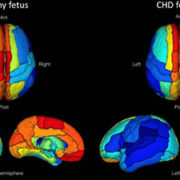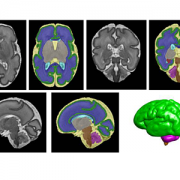Breast milk helps white matter in preemies

Critical white matter structures in the brains of babies born prematurely at low birth weight develop more robustly when their mothers breast-feed them, compared with preemies fed formula.
Breast-feeding offers a slew of benefits to infants, including protection against common childhood infections and potentially reducing the risk of chronic health conditions such as asthma, obesity and type 2 diabetes. These benefits are especially important for infants born prematurely, or before 37 weeks gestation – a condition that affects 1 in 10 babies born in the United States, according to the Centers for Disease Control and Prevention. Prematurely born infants are particularly vulnerable to infections and other health problems.
Along with the challenges premature infants face, there is a heightened risk for neurodevelopmental disabilities that often do not fully emerge until the children enter school. A new study by Children’s National Health System researchers shows that breast-feeding might help with this problem. The findings, presented at the 2017 annual meeting of the Pediatric Academic Societies, show that critical white matter structures in the brains of babies born so early that they weigh less than 1,500 grams develop more robustly when their mothers breast-feed them, compared with preemie peers who are fed formula.
The Children’s National research team used sophisticated imaging tools to examine brain development in very low birth weight preemies, who weighed about 3 pounds at birth.
They enrolled 37 babies who were no more than 32 weeks gestational age at birth and were admitted to Children’s neonatal intensive care unit within the first 48 hours of life. Twenty-two of the preemies received formula specifically designed to meet the nutritional needs of infants born preterm, while 15 infants were fed breast milk. The researchers leveraged diffusion tensor imaging – which measures organization of the developing white matter of the brain – and 3-D volumetric magnetic resonance imaging (MRI) to calculate brain volume by region, structure and tissue type, such as cortical gray matter, white matter, deep gray matter and cerebellum.
“We did not find significant differences in the global and regional brain volumes when we conducted MRIs at 40 weeks gestation in both groups of prematurely born infants,” says Catherine Limperopoulos, Ph.D., director of the Developing Brain Research Laboratory and senior author of the paper. “There are striking differences in white matter microstructural organization, however, with greater fractional anisotropy in the left posterior limb of internal capsule and middle cerebellar peduncle, and lower mean diffusivity in the superior cerebellar peduncle.”
White matter lies under the gray matter cortex, makes up about half of the brain’s volume, and is a critical player in human development as well as in neurological disorders. The increased white matter microstructural organization in the cerebral and cerebellar white matter suggests more robust fiber tracts and microarchitecture of the developing white matter which may predict better neurologic outcomes in preterm infants. These critical structures that begin to form in the womb are used for the rest of the person’s life when, for instance, they attempt to master a new skill.
“Previous research has linked early breast milk feeding with increased volumetric brain growth and improved cognitive and behavioral outcomes,” she says. “These very vulnerable preemies already experience a high incidence rate of neurocognitive dysfunction – even if they do not have detectable structural brain injury. Providing them with breast milk early in life holds the potential to lessen those risks.”
The American Academy of Pediatrics endorses breast-feeding because it lowers infants’ chances of suffering from ear infections and diarrhea in the near term and decreases their risks of being obese as children. Limperopoulos says additional studies are needed in a larger group of patients as well as longer-term follow up as growing infants babble, scamper and color to gauge whether there are differences in motor skills, cognition and writing ability between the two groups.











